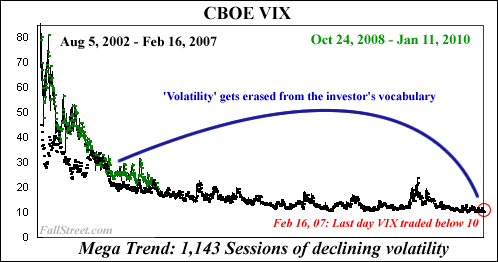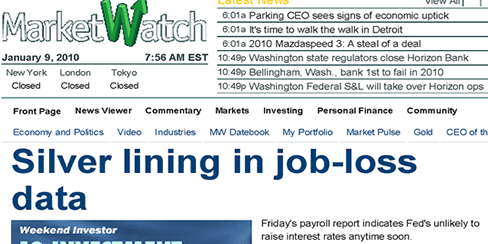January 13, 2010
The Death of Volatility, Part II?
In a recent article the Wall Street Journal noted that the ‘VIX Is No Crystal Ball’, adding that ‘it [the VIX] almost never leads the market in either direction.’ Given that the VIX itself is simply a computation of [options] market activity, this information borders on the pointless. Nevertheless, with many analysts focused on the sharp decline in volatility to begin 2010 this topic is not going away.
The latest slump in volatility has caught the attention of many analysts because the VIX has held below 20 (historically a sign of investor complacency), and because stock prices are long overdue for a correction. While it is difficult to offer an opinion on this development, it is safe to say that should the VIX keep falling and/or stock prices keep rising contrarian spirits will become more aroused.
Longer-term VIX Movements
On January 11, 2010 the VIX traded below 17 for the first time since May 2008.
The recent slump in the VIX has mirrored the previous downturn in the index: 305-trading sessions after peaking at 89.53 on October 24, 2008 the VIX is at the exact same level it was 305-trading session after its August 5, 2002 peak of 45.03 (17.55 on January 11, 2010 versus 17.62 on October 16, 2003).
 |
The data missing from the above charts is displayed below. Note how once volatility moved above its freakishly low sub-10 reading it never returned.
 |
What marked the beginning of this major trend change in the VIX? Consider Goldman, Merrill Almost `Junk,' Their Own Traders Say, dated March 2, 2007:
“Lehman and Bear Stearns credit swaps traded as if their debt were rated four levels lower than their A1 rankings…”
In other words, hindsight tells us that VIX spike in early 2007 (and the events surrounding/prompting it) signaled a coming tsunami of problems for the U.S. economy and financial markets.
With this in mind, one suggestion may be the next time the VIX spikes sharply higher read the headlines closely and try to determine whether the issues influencing the spike are burgeoning or transient. In the case of yesterday’s tiny move higher in the VIX, a predetermined pessimist expecting say Japan to soon default could relate it with the following:
“The cost of protecting Asia-Pacific corporate and sovereign bonds from default rose on U.S. earnings concerns and after China’s central bank unexpectedly moved to restrain lending…”
Given that it may be foolish to carry this potentially specious reasoning much further, let me close by saying that in the absence of a major world event a sustained move higher in the VIX is unlikely to occur until either the secular bear market returns and/or the U.S. nears another recession. That neither of these events is on the radar screen today largely explains why the VIX is trending lower…
January 9, 2010
Underwater and Lovin’ It?
The headline from MarketWatch this morning reads ‘Silver lining in job-loss data’. While you would expect to find optimistic takes on what was clearly a negative jobs report, the line below the ridiculous headline was nonetheless shocking:
“Friday's payroll report indicates Fed's unlikely to raise interest rates anytime soon.”
 |
That the U.S. recovery is so feeble the Fed can not raise rates above zero percent is considered a ‘silver lining’? By this standard Japan is the undisputed king at collecting silver linings, although for what good such linings serve I do not know...
The U.S. has lost 7.24 million jobs since January 2008 (Excel) and the U.S. government has shed 89 thousand government jobs since September 2008 (another 21 thousand U.S. government jobs were lost in December). Jobs losses at this stage of the game are ominous news for the investors, politicians, and regulators that are collectively holding their breath waiting for recovery – they have been holding their breath for about 17 minutes versus David Blaine’s under water record of 17 minutes and four seconds.
In short, the U.S. economy must (and likely will) start producing jobs very soon, or the outlook for the U.S. financial markets and U.S. dollar could turn decidedly negative as policy makers reluctantly admit defeat and plan what is sure to be yet another borrow/spend exhale strategy.
BLS ~ Northern Trust Coverage
November 27, 2009
Dubai Contagion
It is a theme that is often repeated: borrow money to build something – anything – and hope that you can pay the money back some day. For Dubai, hope has turned to heartache as conglomerate Dubai World has asked creditors for a debt reprieve until May 2010. When things were booming Dubai World constructed the world’s tallest building and one of its subsidiaries, developer Nakheel, built a palm-tree shaped island. To state the obvious, these and other extravagant projects have not produced the expected returns. In fact, in the case of the iconic Palm Island, it hasn’t even been completed yet.
“When construction began in 2001, the project was the largest land reclamation venture ever, involving close to 100 million cubic metres of sand and seven million tonnes of rock.
The development was supposed to be finished in 2005 but it is still not done. When it is complete, about two million people will live on the island's 16 palm fronds and along the 11-kilometre surrounding crescent.
Nakheel is working on two other palm-tree-shaped islands nearby and another island project shaped like the globe.”
Globe & Mail
As interesting as it is to read about Dubai’s eye-catching property developments, the measly $59 billion in liabilities at Dubai world barely seems worthy of mention. And while under ordinary circumstances this would hold true, circumstances have hardly been ordinary. Instead the markets have been on a historic roller coaster ride – rapidly plunging in 2008 as the financial system teetered on the brink and then soaring after prices ‘bottomed’ in March 2009. Now, with an 8-month financial boom on the books, the possibility of Dubai’s debt problems marking the start of the greed/fear pendulum’s swing back in the other direction has entered into mind of investors.
In short, the $59 billion number is irrelevant. What other financial nightmares, if any, are about to be unleashed is what has everyone scrambling…
Dubai struggles to assuage debt fear Reuters
The announcement sowed fear of a contagion NYT
Dubai debt drama revives fears of contagion Times Online